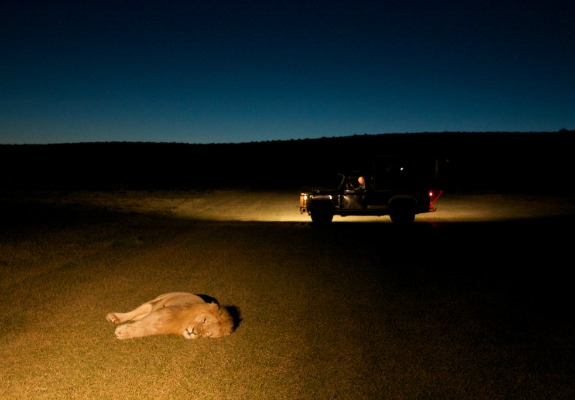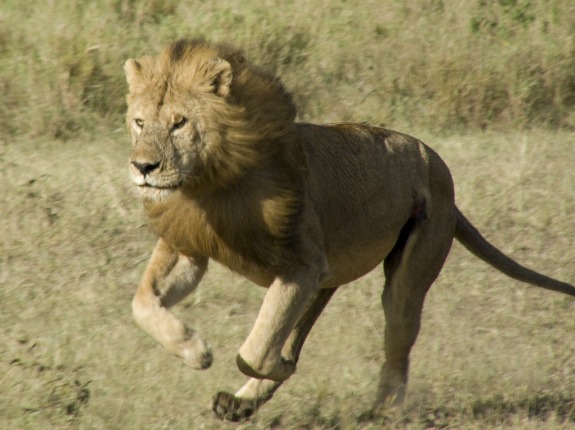Should Trophy Hunting of Lions Be Banned?
Some argue that tourist safari hunts generate important money for African nations—but can lions afford the loss?
Their numbers are declining, but lions remain a legal target of trophy hunters in Africa. Big males, like this one, are potential trophies. Photo courtesy of Flickr user suburbanchicken.
Nowhere in the world is it legal to hunt wild tigers, as each remaining subspecies of the giant cat is infamously on the verge of extinction.
Yet the close cousin of the tiger, the lion—almost equally large, equally charismatic and, in places, equally threatened—is legally killed by trophy hunters across its shrinking African range. The remaining lion population, centered in eastern and southern Africa, has declined by as much as 30 percent in the past 20 years, and the cats are considered seriously imperiled. Yet every year 600 lions fall to the bullets of licensed and legal tourists on safari hunts. The activity is opposed by many, but those in favor argue that trophy hunting of lions and other prized targets generates employment and revenue for local economies. The Huffington Post ran an editorial in March 2011 in which the author—lion researcher Luke Hunter—condemned the act of shooting a big cat but still argued that lion hunting is an important tool in generating revenue for land preservation. The author reported that trophy-hunting tourists may pay $125,000 in fees and guide services for the privilege of killing a lion, and he questioned the wisdom in protecting the animals under the Endangered Species Act, an action the U.S. Fish and Wildlife Service is considering. A hunter’s organization called Conservation Force also makes the case on its website that African “tourist safari hunting” benefits land, wildlife and communities while imparting “no detrimental biological impact.”
But a report published in 2011 says otherwise—that the environmental and economic benefits of trophy hunting in Africa are negligible. The paper, produced by the International Union for Conservation of Nature, states that in 11 sub-Saharan countries that allow trophy hunting of large game, 272 million acres—or 15 percent of the land—is open to the sport. However, returns from trophy hunting are dismal. While hunters in Africa kill, in addition to lions, 800 leopards, 640 elephants and more than 3,000 water buffalo each year, among other species, they leave behind only 44 cents per acre of hunting land. In Tanzania, that figure is much smaller—a per-acre benefit of less than two cents. A closer look by the report’s authors at seven of the 11 countries—Namibia, Tanzania, Botswana, Cameroon, Central African Republic, Burkina Faso and Benin—revealed that trophy hunting employs not even 10,000 people on a permanent and part-time basis. About 100 million people live in these seven nations.
The IUCN’s report points out that since the economic benefits of trophy hunting appear to be virtually nil in Africa, the only way hunting can be used as a conservation tool is by allowing it as part of carefully designed conservation strategies. Which beckons the question: What species are to gain by hunters prowling their habitat? Certainly, in some cases of overpopulation—usually of grazing herd animals—hunting can serve a direct purpose and even benefit ecosystems. Even elephants are widely said to be overpopulated in certain locations and in need of intervention via rifles.

Female and juvenile lions are off-limits to hunters, but whole prides may be impacted when trophy hunters remove the most powerful breeding males from a population. Photo courtesy of Flickr user kibuyu.
But for lions, can the intentional removal of any animals from remaining populations be tolerated? Their numbers are crashing from historic levels. Lions once occurred in most of Africa, southern Europe, the Arabian peninsula and southern Asia as far east as India. But nation by nation, lions have disappeared. In Greece, they were gone by A.D. 100. In the 1100s, lions vanished from Palestine. The species’ greatest decline occurred in the 20th century, when Syria, Iran and Iraq saw their last lions die. In 1950, there may have been 400,000 left in the wild; by 1975, perhaps only 200,000. By the 1990s, their numbers had been halved again. Today, an isolated population in the Gir Forest of India numbers more than 400 and seems even to be growing. But the current African population of 32,000 to 35,000 is declining fast. (Defenders of Wildlife has estimated that not even 21,000 lions remain.) In Kenya, the situation is dire: In 2009, wildlife officials guessed they were losing about 100 lions per year in a national population of just 2,000 and that they might be extinct within 20 years. The causes are multiple but related; loss of habitat and decline of prey species are huge factors which, in turn, mean increased lion conflicts with livestock herders—and, often, dead lions; and as numbers drop, the gene pool is dwindling, causing inbreeding and weakened immune systems. Disease outbreaks have also had devastating impacts.
Then there is trophy hunting, which may remove powerful breeding males from a population. David Youldon, the chief operating officer of the conservation group Lion Alert, said in an e-mail that no existing lion population needs culling. The only potential benefit from hunting could come as revenue for land preservation and local communities—but this, he says, isn’t happening.
“Hunting has the potential to generate conservation benefits, but the industry needs a complete overhaul, improved regulation and greater benefit to Africa if such benefits are to be realized, and I see little motivation within the industry to make those changes,” he wrote.
Incredibly, as lions disappear, tourists spur the decline; they may still shoot lions in Benin, Botswana, Burkina Faso, Cameroon, Central African Republic, Mozambique, Namibia, South Africa, Tanzania, Zambia and Zimbabwe. Ethiopia also allows very limited hunting. Fifty-three percent of the cats are taken by Americans, according to Lion Alert, which has reviewed the IUCN’s report and warns on its website that the societal benefits of hunting in most of Africa are so minimal that the activity, in effect, creates little or no impetus to preserve land for the activity, maintain populations of target animals or stop poaching.
So what can travelers do to help? Take more pictures, perhaps. “Photographic tourism” generates 39 times the permanent employment that trophy hunting does, the IUCN report says, while protected lands generate on average two times the tourist revenue per acre as do hunting reserves. That is still just pennies—but at least it leaves the lions alive.

A male lion naps as a safari jeep’s spotlight illuminates it for photographers, which reportedly generate almost two times the revenue per acre of land as do trophy hunters. Photo courtesy of Flickr user russelljsmith.
Other Big Cats to Protect—and See While You Can:
Tiger. Since 1900, tiger numbers from Turkey to Malaysia have dropped by 95 percent. Today, between 4,000 and 7,000 remain, and the outlook is grim. The largest population lives in India, where tourists have the best chance at seeing wild tigers in Ranthambore National Park, Kanha National Park and Bandhavgarh National Park.
Cheetah. The world’s fastest land animal once lived in 44 countries in Asia and Africa, with a population of possibly 100,000. Today, most cheetahs live in Africa, where numbers are down to as low as 10,000. A gene pool bottleneck thousands of years ago has left a legacy of inbreeding, one of the major threats to the cheetah’s survival. For now, an excellent place to see cheetahs is Kafue National Park, in Zambia.
Snow Leopard. The granite-colored snow leopard of the Himalaya numbers possibly 6,000 in 12 nations, but, like most wild cats, the snow leopard is disappearing. Trekkers in the Himalaya (PDF) have the best chance, though unlikely, of catching a glimpse.
Clouded Leopard. Perhaps the most mysterious of the big cats—and definitely the smallest—the clouded leopard ranges from Tibet through southern China and south through the islands of Malaysia and Indonesia. The animals weigh just 30 to 50 pounds and spend much of their time in trees. The current population is unknown but believed to be less than 10,000 individuals and shrinking. Seeing clouded leopards is rare—and we may take satisfaction simply in knowing that this beautiful creature exists.

The endangered snow leopard, a resident of the Himilayas, is rarely seen in the wild. This one lives in a zoo. Photo courtesy of Flickr user Tambako the Jaguar.
Planning Your Next Trip?
Explore great travel deals
Smithsonian magazine participates in affiliate link advertising programs. If you purchase an item through these links, we receive a commission.
/https://tf-cmsv2-smithsonianmag-media.s3.amazonaws.com/accounts/headshot/Off-Road-alastair-bland-240.jpg)

/https://tf-cmsv2-smithsonianmag-media.s3.amazonaws.com/accounts/headshot/Off-Road-alastair-bland-240.jpg)